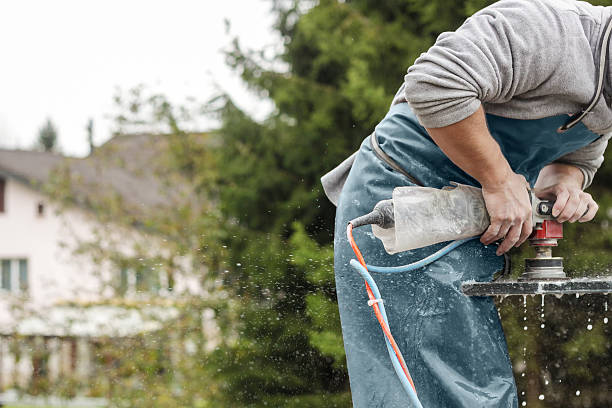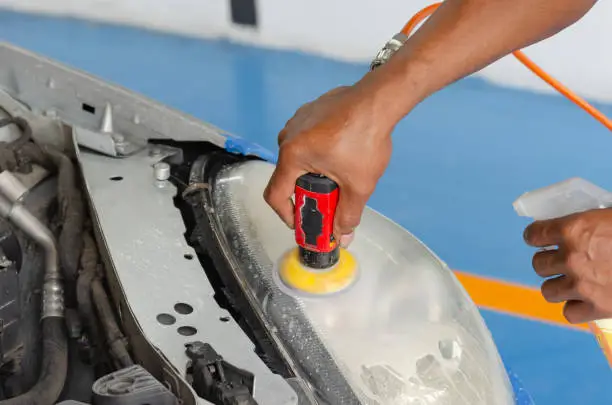Looking to give your DIY project a smooth and flawless finish? Wondering if you can use a random orbital sander for wet sanding? Well, you’ve come to the right place! In this article, we’ll explore the fascinating world of wet sanding with a random orbital sander.
You might already be familiar with the random orbital sander – a versatile tool that helps remove imperfections and smoothes surfaces. But can it handle the challenges of wet sanding? Let’s find out!
Whether you’re a seasoned DIY enthusiast or just starting out, wet sanding with a random orbital sander can be a game-changer. So, let’s dive in and discover the possibilities together!

Can You Wet Sand with a Random Orbital Sander?
Wet sanding is a commonly used technique in the world of DIY and professional woodworking. It involves using a lubricant, such as water or a mixture of water and soap, to remove imperfections and create a smooth surface. On the other hand, a random orbital sander is a versatile tool that uses a circular sanding motion to quickly and efficiently remove material. But can you combine these two techniques? Can you wet sand with a random orbital sander? In this article, we will explore the possibilities and limitations of wet sanding with a random orbital sander, and provide some tips on how to achieve the best results.
Understanding Wet Sanding
Before we dive into the question of whether you can wet sand with a random orbital sander, let’s first understand what wet sanding is. Wet sanding is a sanding technique that involves using a lubricant to reduce friction during the sanding process. The most common lubricant used is water, but some professionals prefer to use a mixture of water and soap. Wet sanding not only helps to remove imperfections and scratches from the surface being sanded, but it also helps to prevent clogging of the sandpaper, resulting in a more efficient sanding process. Wet sanding is commonly used in automotive refinishing, as well as when working with certain types of wood and finishes.
Benefits of Wet Sanding with a Random Orbital Sander
Now that we have a basic understanding of wet sanding, let’s explore the benefits of combining this technique with a random orbital sander. The random orbital sander is known for its ability to deliver a smooth and swirl-free finish, making it a popular choice among woodworkers and DIY enthusiasts. When used in conjunction with wet sanding, the random orbital sander can provide even better results. The lubricant helps to reduce heat and friction generated during the sanding process, preventing the sandpaper from clogging and ensuring a smooth and consistent finish. Additionally, wet sanding with a random orbital sander can help to minimize dust and debris, making it a cleaner and more convenient option compared to traditional dry sanding.
Some of the key benefits of wet sanding with a random orbital sander include:
- Reduced heat and friction, resulting in less damage to the surface being sanded
- Prevention of sandpaper clogging, leading to a more efficient sanding process
- Achievement of a smoother and swirl-free finish
- Minimized dust and debris, creating a cleaner workspace
The Limitations of Wet Sanding with a Random Orbital Sander
While wet sanding with a random orbital sander offers numerous benefits, it also has its limitations. One of the main limitations is that not all random orbital sanders are designed to be used with water or other lubricants. Some models may not have the necessary seals or protections to prevent water from entering the motor or electrical components of the sander, potentially causing damage. It is essential to check the manufacturer’s guidelines and specifications before attempting to wet sand with a random orbital sander.
Additionally, the use of water or a lubricant can affect the grip and control of the sander, making it harder to maneuver and potentially leading to less precise results. The excess moisture can also make it challenging to see the progress of the sanding and identify any remaining imperfections. It is crucial to strike the right balance between adding enough lubricant for a smooth sanding process and not over-saturating the surface.
Despite these limitations, many woodworkers and professionals successfully wet sand with a random orbital sander by taking necessary precautions and using the appropriate techniques. With proper care and attention to detail, the combination of wet sanding and a random orbital sander can result in outstanding finishes and save time compared to traditional sanding methods.
Tips for Wet Sanding with a Random Orbital Sander
If you decide to try wet sanding with a random orbital sander, here are some tips to help you achieve the best results:
1. Choose the Right Sandpaper
Use sandpaper specifically designed for wet sanding. Look for sandpaper with a waterproof backing and the appropriate grit for your project.
2. Protect the Sander
Ensure your random orbital sander is suitable for wet sanding by checking the manufacturer’s guidelines. Consider using a sander with a sealed motor and protection against water intrusion.
3. Use the Right Amount of Lubricant
Find the right balance between adding enough lubricant for a smooth sanding process and not over-saturating the surface. Too much lubricant can make the sandpaper ineffective and create a mess, while too little may result in excessive heat and friction.
4. Take Precautions
When working with water or a water-based lubricant, ensure that you take necessary precautions to protect yourself and your workspace. Wear appropriate protective gear such as goggles and gloves, and cover any electrical outlets or sensitive equipment that could be damaged by moisture.
5. Work in Small Sections
Divide the surface into small sections and focus on one area at a time. This approach allows you to maintain better control over the sanding process and monitor the progress closely.
6. Check the Surface Regularly
Periodically wipe away the excess lubricant and inspect the surface to ensure that you are achieving the desired results. This step also helps you identify any remaining imperfections and adjust your technique if needed.
7. Clean and Dry Thoroughly
After completing the wet sanding process, thoroughly clean and dry the surface before proceeding with any additional steps or finishes. This helps to ensure a clean and professional-looking final result.
By following these tips and taking the necessary precautions, you can safely and effectively wet sand with a random orbital sander, achieving outstanding results in your woodworking projects.
Key Takeaways: Can You Wet Sand with a Random Orbital Sander?
- Yes, you can wet sand with a random orbital sander.
- Wet sanding with a random orbital sander can reduce dust and get a smoother finish.
- Ensure to use waterproof sandpaper and keep it wet throughout the sanding process.
- Wet sanding can be used for automotive, woodworking, and other projects.
- Cleaning and drying the sander properly after wet sanding is essential for its longevity.
Frequently Asked Questions
In this section, we will address some common questions related to using a random orbital sander for wet sanding.
1. Can you wet sand with a random orbital sander?
Yes, you can wet sand with a random orbital sander. However, it’s important to note that not all random orbital sanders are designed for wet sanding. To wet sand with a random orbital sander, you would need a sander specifically designed for both wet and dry sanding. These sanders usually come with additional features that make them suitable for handling water, such as sealed switches and corrosion-resistant materials.
Wet sanding with a random orbital sander can be useful for certain applications. It can help in reducing dust, preventing clogging of the sandpaper, and providing a smoother finish. However, it’s important to follow the manufacturer’s instructions and recommendations for using the sander in wet conditions to avoid any damage to the tool.
2. What are the advantages of wet sanding with a random orbital sander?
Wet sanding with a random orbital sander offers several advantages over dry sanding. Firstly, it reduces the amount of dust produced during the sanding process, making it a cleaner and healthier option, especially when working indoors or in confined spaces. Additionally, wet sanding helps to keep the sandpaper from clogging, allowing it to maintain its cutting ability for a longer period.
Furthermore, wet sanding with a random orbital sander can result in a smoother finish. The water acts as a lubricant, reducing friction and heat, which can help to prevent sanding marks and swirls on the surface. This is particularly beneficial when working on automotive finishes, woodworking projects, or other applications that require a high-quality, polished outcome.
3. Are all random orbital sanders suitable for wet sanding?
No, not all random orbital sanders are suitable for wet sanding. It’s important to check the specifications of the sander before using it for wet sanding. Some random orbital sanders are designed only for dry sanding and may not have the necessary features to handle water. These sanders may get damaged or malfunction if used for wet sanding.
If you plan to wet sand with a random orbital sander, make sure to look for a model specifically designed for wet and dry sanding. These sanders often have features like sealed on/off switches, rubberized grips, and corrosion-resistant materials to withstand the water. Read the manufacturer’s instructions and recommendations to ensure you are using the sander correctly.
4. What type of sandpaper should I use for wet sanding with a random orbital sander?
When wet sanding with a random orbital sander, it’s important to use sandpaper specifically designed for wet sanding. These sandpapers are typically waterproof and have a special coating or adhesive that can withstand exposure to water. Using regular sandpaper for wet sanding can cause the paper to disintegrate or lose its cutting ability quickly.
There are different grits available for wet sanding, just like with dry sanding. The choice of grit depends on the level of smoothness and the amount of material you need to remove. Start with a coarser grit for heavy sanding, and gradually move to finer grits for a smoother finish. Follow the sandpaper manufacturer’s recommendations for durability, grit progression, and compatibility with your sander.
5. What precautions should I take when wet sanding with a random orbital sander?
When wet sanding with a random orbital sander, it’s important to take some precautions to ensure your safety and the best results. Firstly, make sure you have a workspace that is adequately protected from water damage. Use waterproof sandpaper and work in an area with proper ventilation to minimize the accumulation of moisture.
Additionally, ensure that the sander you are using is designed for wet sanding and has the necessary safety features. Always follow the manufacturer’s instructions and recommendations for using the sander in wet conditions. Avoid getting water into the electric components of the sander and never operate the sander with wet hands.
Lastly, wear appropriate personal protective equipment (PPE), such as safety goggles and a dust mask, to protect yourself from any potential hazards. Wet sanding may generate slurry, which can be messy, so consider using adequate barriers or containment to prevent water from splashing onto surrounding surfaces.

How to MACHINE WET SAND!! Using air assisted, electric, pneumatic, water fed
Summary
Wet sanding with a random orbital sander is possible, but precautions must be taken. Wet sanding can be used to achieve a smoother finish and reduce dust. However, it requires using waterproof sandpaper and being careful not to damage the sander.
While wet sanding can provide better results, it can also increase the risk of water damage to the sander’s motor. It is important to follow the manufacturer’s guidelines and use the correct technique to avoid potential problems. Always be cautious when working with water and electricity.
